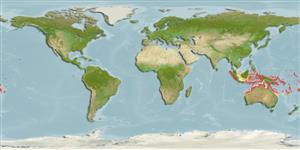Teleostei (teleosts) >
Kurtiformes (Nurseryfishes, cardinalfishes.) >
Apogonidae (Cardinalfishes) > Apogoninae
Etymology: Fowleria: Taken from Fowler, ichthyiologist, 1945 (Ref. 45335).
Eponymy: Henry Weed Fowler (1878–1965) was an American herpetologist, ornithologist, ichthyologist and artist. [...] (Ref. 128868), visit book page.
Environment: milieu / climate zone / depth range / distribution range
Ecology
Marine; reef-associated; depth range 7 - 30 m (Ref. 11890). Tropical; 6°N - 26°S, 95°E - 172°W
Western Pacific: Madang and Manus Island, northern Papua New Guinea and Philippines (Ref. 90102). Recently reported from Indonesia (Ref. 47567) and Tonga (Ref. 53797).
Size / Weight / Age
Maturity: Lm ? range ? - ? cm
Max length : 3.1 cm SL male/unsexed; (Ref. 11890)
Inhabits sheltered lagoon waters with scattered coral outcrops (Ref. 11890). Solitary and cryptic, seldom seen during day (Ref 90102).
Life cycle and mating behavior
Maturity | Reproduction | Spawning | Eggs | Fecundity | Larvae
Distinct pairing during courtship and spawning (Ref. 205).
Allen, G.R., 1993. Cardinalfishes (Apogonidae) of Madang Province, Papua New Guinea, with descriptions of three new species. Rev. Fr. Aquariol. 20(1):9-20. (Ref. 11890)
IUCN Red List Status (Ref. 130435: Version 2024-1)
Threat to humans
Harmless
Human uses
Fisheries: of no interest
Tools
Special reports
Download XML
Internet sources
Estimates based on models
Preferred temperature (Ref.
123201): 26.2 - 29.3, mean 28.5 °C (based on 1211 cells).
Phylogenetic diversity index (Ref.
82804): PD
50 = 0.5078 [Uniqueness, from 0.5 = low to 2.0 = high].
Bayesian length-weight: a=0.01445 (0.00680 - 0.03071), b=3.07 (2.89 - 3.25), in cm total length, based on LWR estimates for this (Sub)family-body shape (Ref.
93245).
Trophic level (Ref.
69278): 3.2 ±0.5 se; based on size and trophs of closest relatives
Resilience (Ref.
120179): High, minimum population doubling time less than 15 months (Preliminary K or Fecundity.).
Fishing Vulnerability (Ref.
59153): Low vulnerability (10 of 100).
